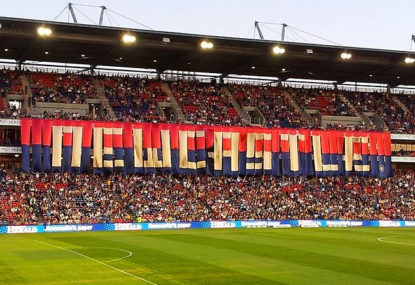A few weeks ago the Newcastle Jets’ main supporter base, the Squadron, announced they will cease to exist on the terraces while the FFA’s measures to “restrict” active supporters remain in place.
In June this year, Football Federation Australia announced “measures to enhance and protect the unique atmosphere created by active supporters” at A-League matches.
The new protocols included membership-only restrictions for active support areas, meaning that fans in supporter bases now have to buy a membership to enter the designated zone.
This was designed to “grow membership and deepen fan engagement”, but fan groups across the country weren’t too receptive. While most will be well aware of the development, many might not realise that the first fallout from the restrictions has arrived.
Larger supporter groups, such as the Cove, the Den and the Red and Black Bloc, were vocally opposed to the FFA’s new rules, but have so far been unprepared to boycott during match days.
The Squadron’s decision to disband their active support, which went largely unreported in mainstream media, represents the first active protest from any fan-base.
Their main gripe, and it’s a valid one, is that the new protocols have put all supporter groups into one basket.
“We cannot accept the new restrictions for active support this season,” the Squadron’s statement read.
“The Squadron FSC will be vacating the designated active supporter bay for the 2014-15 season, or until such time as these restrictions are removed.
“This is not an action against the Newcastle Jets, it is however a response to the absurd and overbearing one-size-fits-all FFA restrictions.”
At the time of the original announcement, the FFA said they were committed to working with clubs to “customise solutions”, yet that seems to have fallen by the wayside in negotiations with the Jets, who represented the Squadron on their behalf.
In recent years the Squadron’s numbers have visibly diminished, but they still occupy a significant part of the stadium and contribute to the match day atmosphere. Some of the A-League’s best tifos have been displayed at Hunter Stadium.
The Squadron will mainly be affected by these changes because the majority of their participants are teenagers. They don’t have the financial means to commit to a membership, bar having rich parents.
“A no-membership, no-access restriction disadvantages this key demographic of our support,” the Squadron said.
They also feel the new measures do not allow for “free and organic support”, outlining that numbers can’t be pinpointed as support ebbs and flows dependent on the score line and situation.
One beautiful part of active support is seeing numbers swell when the team needs the fans the most – when they’re defending a one-goal lead in extra time, or need a last-minute winner. Active support is spontaneous and it shouldn’t be hindered without just cause.
The Jets’ website states that the “Squadron is considered integral to the success of match day and growing fans’ support through other parts of Hunter Stadium”.
So why are the FFA, who constantly use active support as a point of difference from other football codes, potentially ripping it away from the game? It’s clear that they’ve already caused the Jets to lose a strong part of their identity.
It’s not that the restrictions are particularly hard line, it’s just that they’re unnecessary. How it “enhances” club culture is a mystery. The FFA are not seeking to protect, as they claim, but to control.
The true reasoning behind FFA’s decision, despite not alluding to it, could partly be down to the fact that non-members were responsible for lighting flares within the Red and Black Bloc during Western Sydney Wanderers matches last season.
So restrictions are arguably warranted for the Wanderers, who were FFA-owned at the time, but why are the other nine clubs included as well? Why does the FFA feel the need to impose these sanctions, which aren’t going to the heart of the problem anyway?
The changes could be detrimental to the league’s growth, and that has partly been confirmed with the disbanding of the Squadron.
Active support is a major selling point for clubs, but forcing supporters to buy memberships is counter-productive. Instead of imposing restrictions they should enforce a set of rules for active support to adhere to. Those that misbehave and have problems should then be handed restrictions.
It must be noted, however, that Melbourne City announced on July 30 that they would be expanding their active support area due to high demand in Bays 16, 17 and 18. So for some clubs at least, the changes are not having a detrimental effect.
Despite larger support groups expressing their outrage at the new protocols, the Squadron is the first to take action. While it’s a significant and bold move, it would have been a stronger, and more publicised, statement coming from Melbourne Victory or Sydney FC’s fan-base.
It’s rumoured that Victory and Wanderers management approached the FFA about introducing the new measures. If that’s true, then clubs should impose sanctions individually, leaving the rest of the A-League franchises out of it. If there’s a problem at one club, fix it with a customised approach.
The new measures are dumping all football fans into one rigid and unreasonable pen. This one-size-fits-all solution is a farce, and we’ll have to wait and see whether the Squadron is the last supporter group to make a stand.





























































































